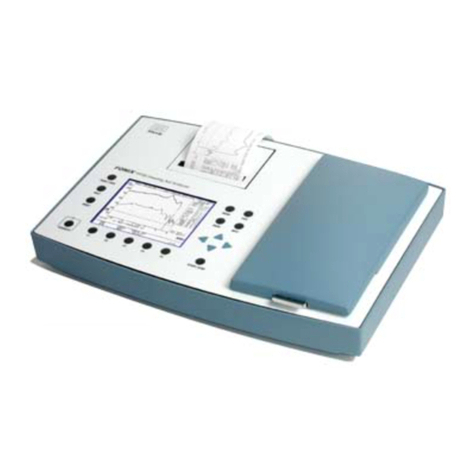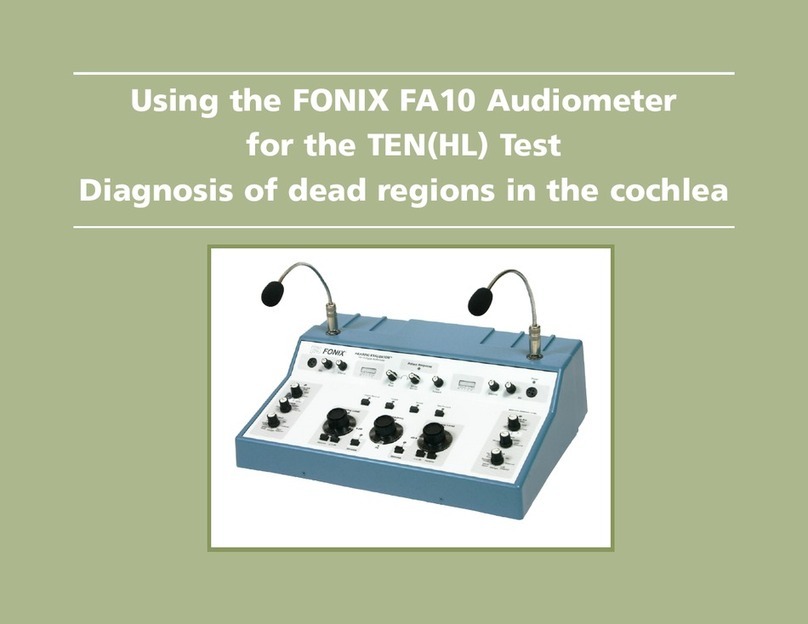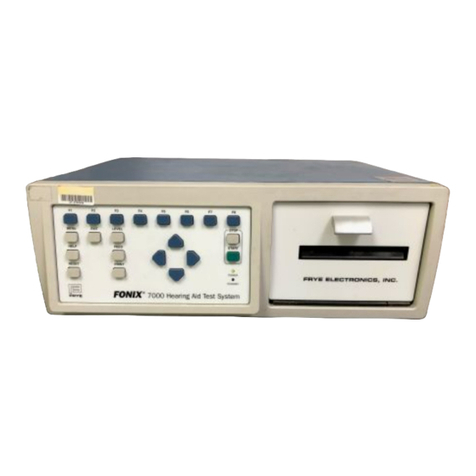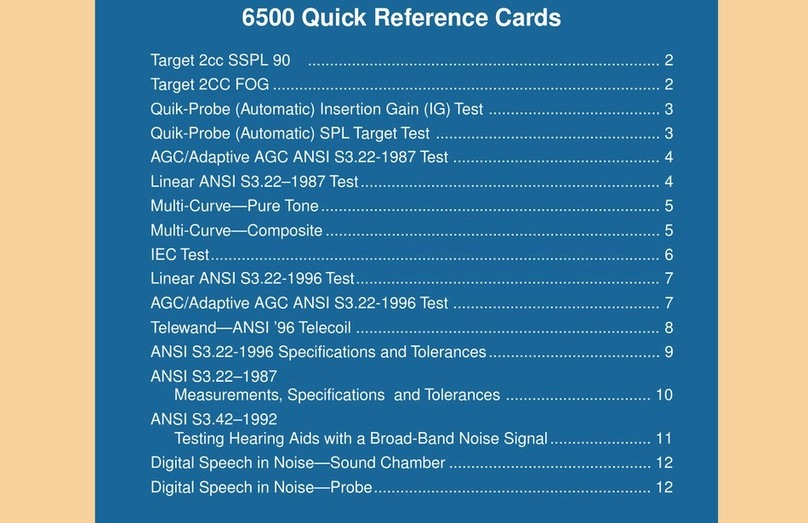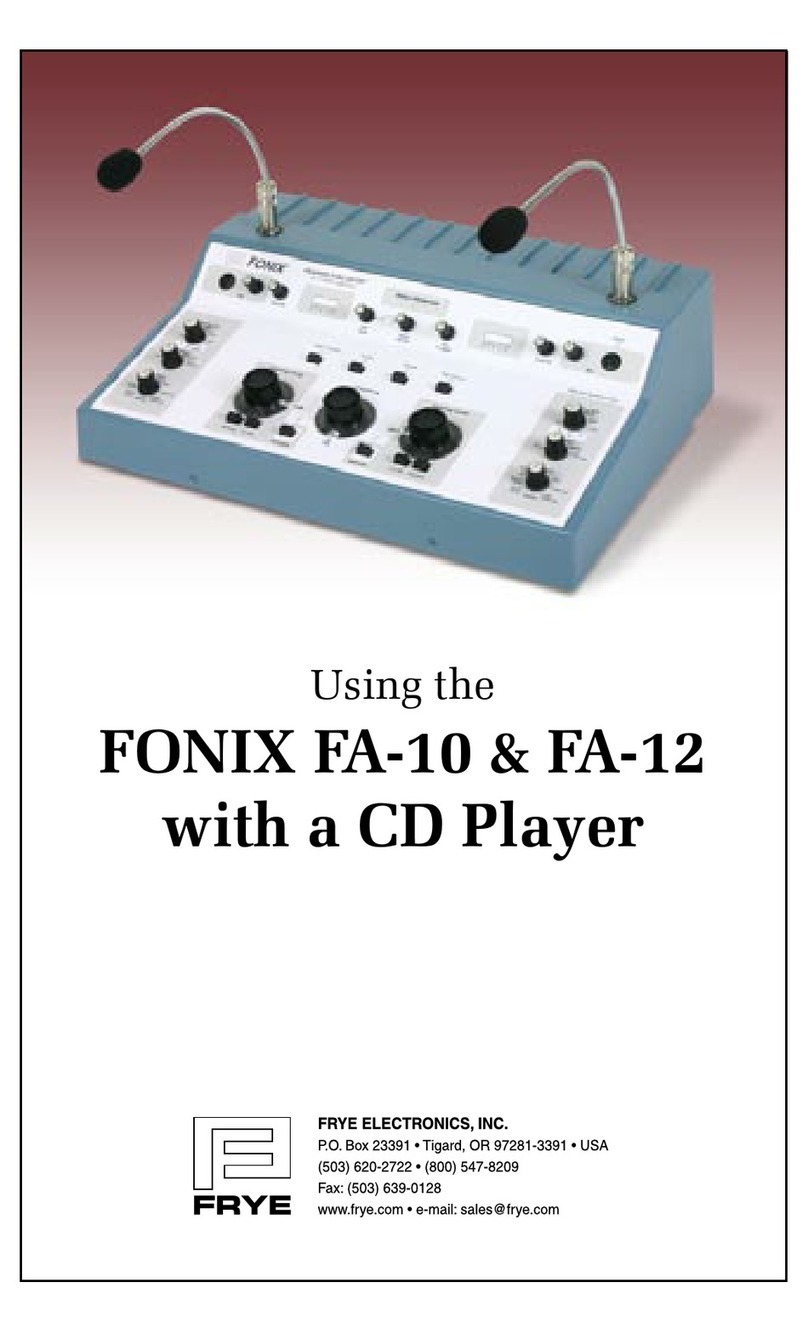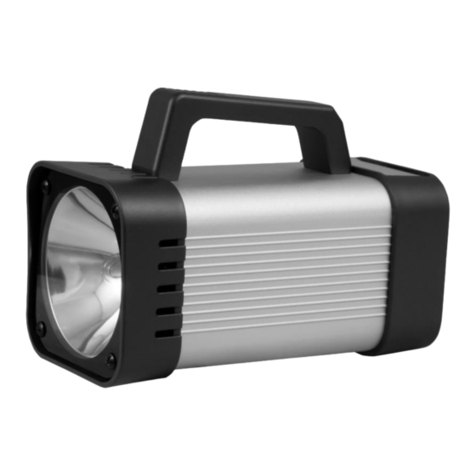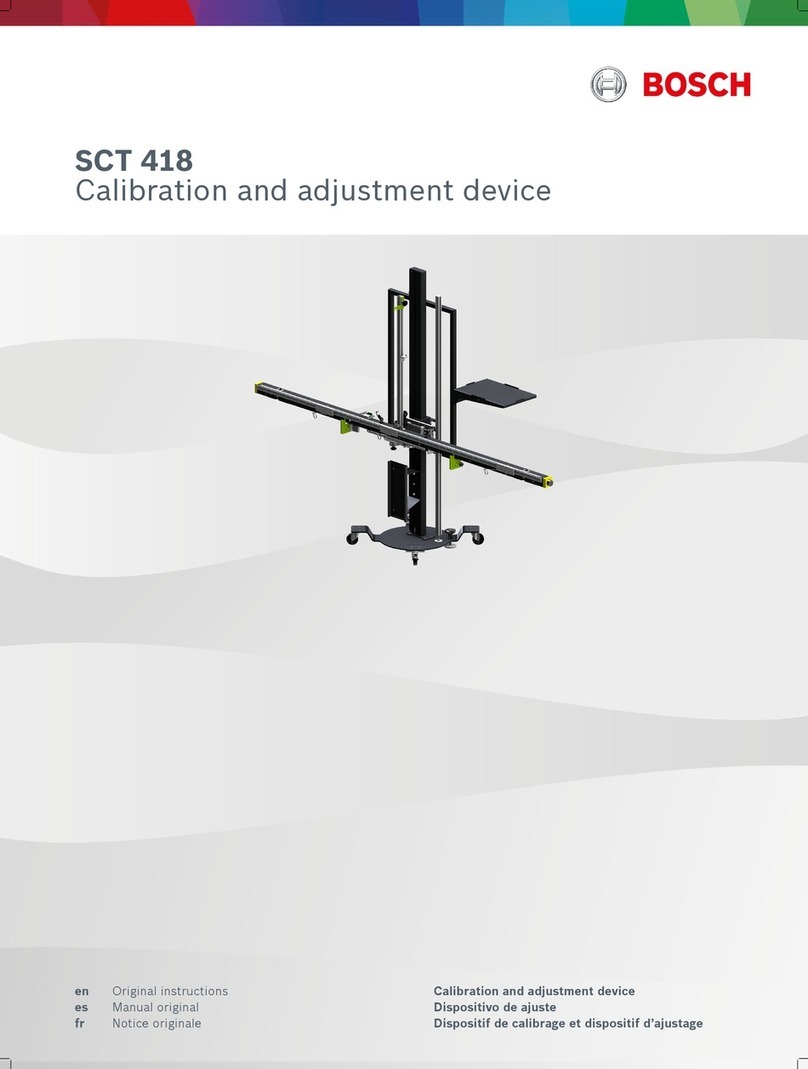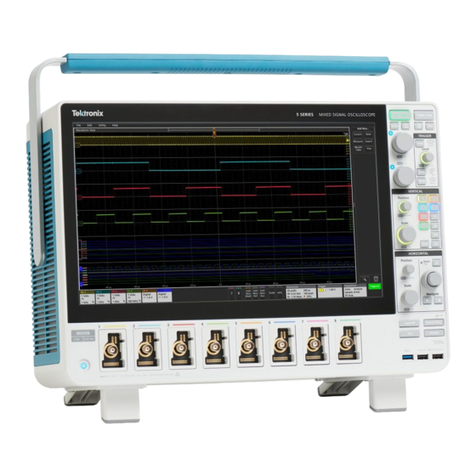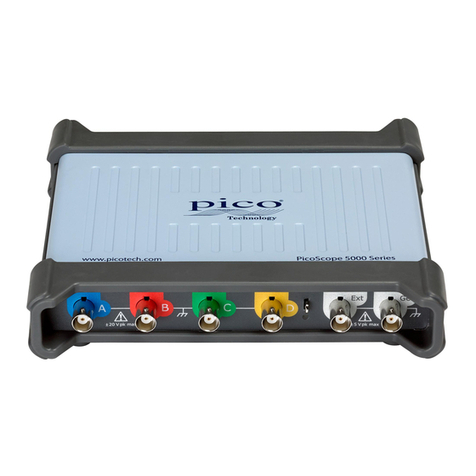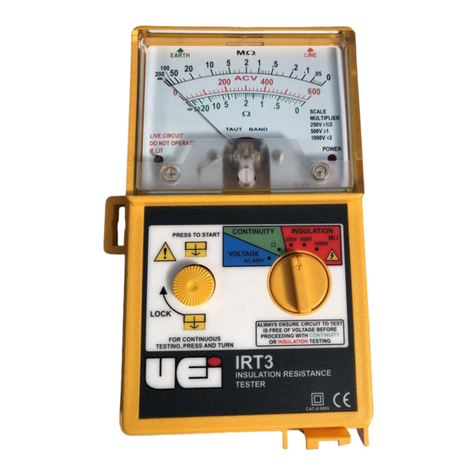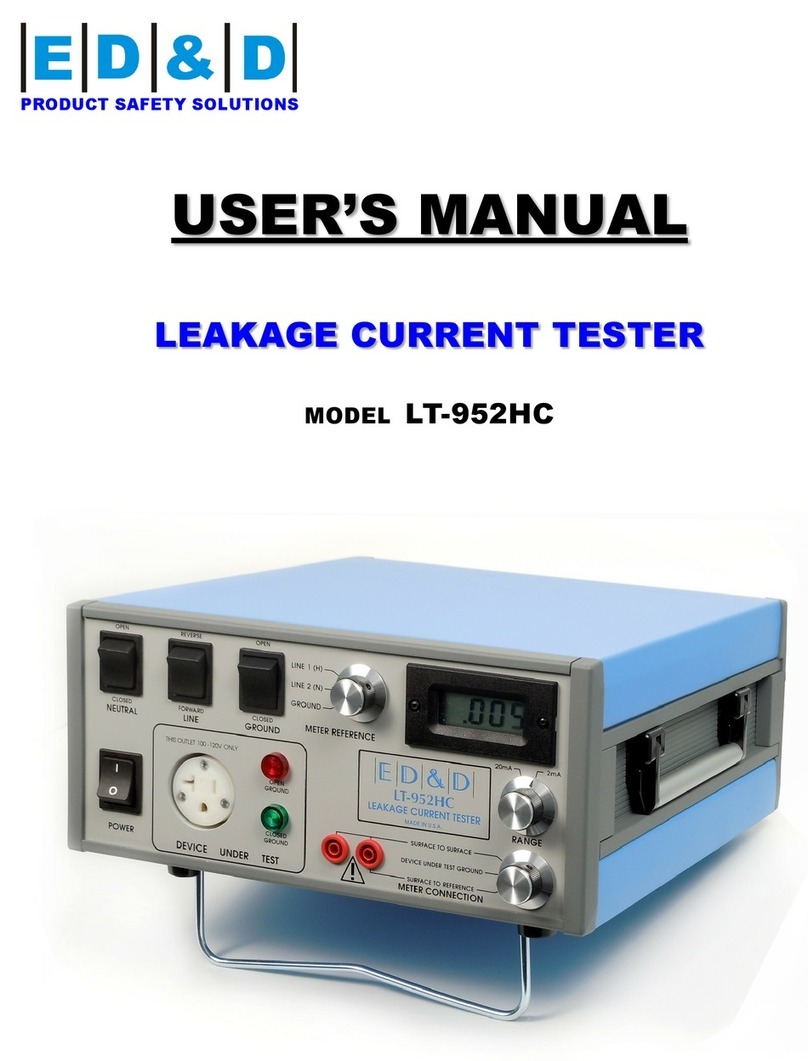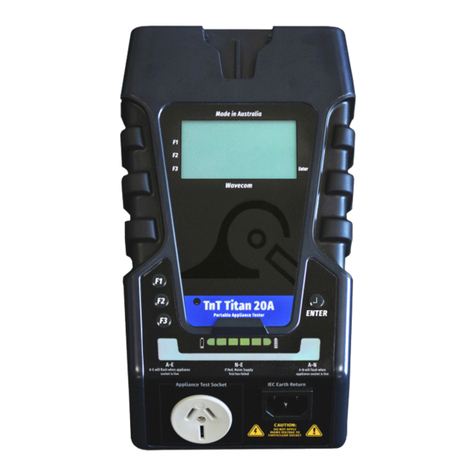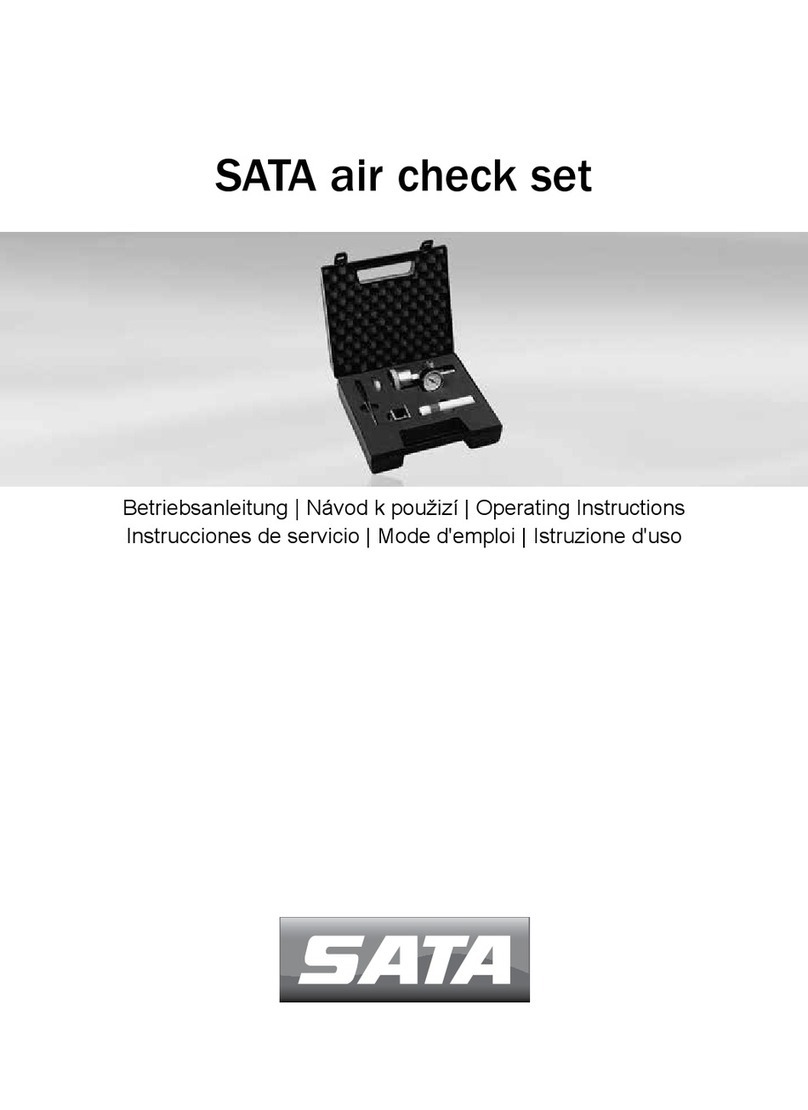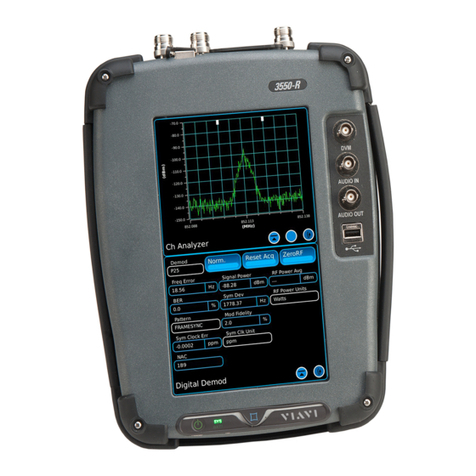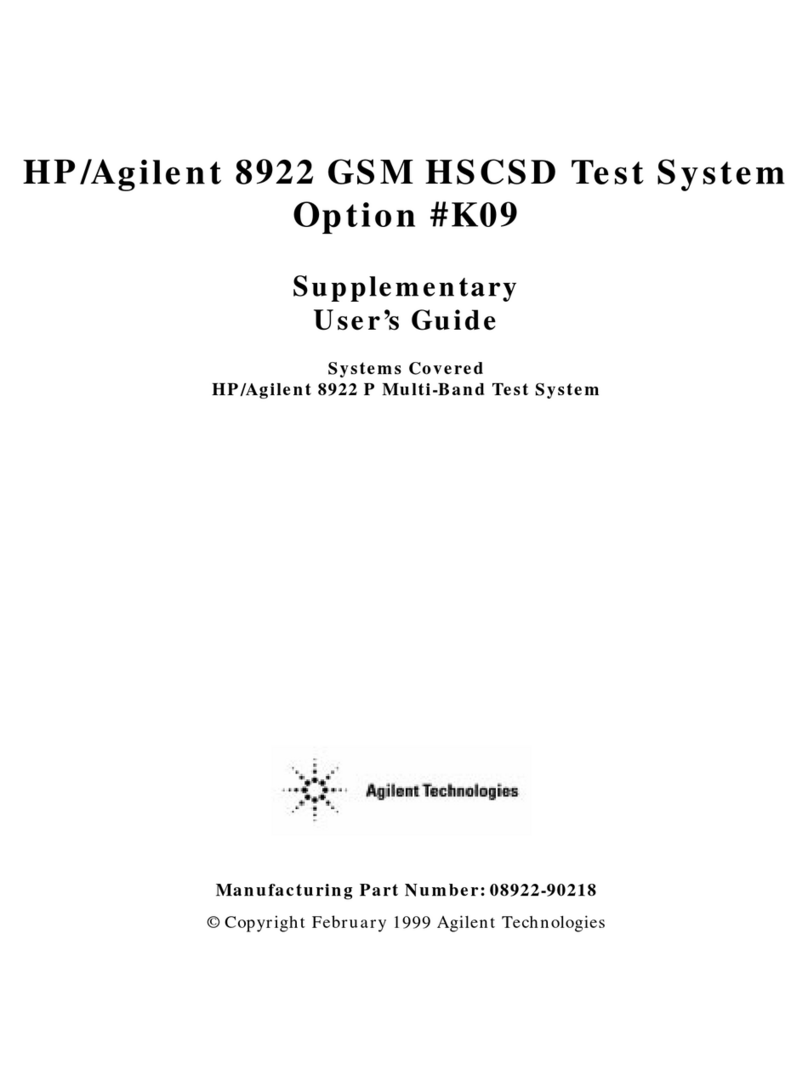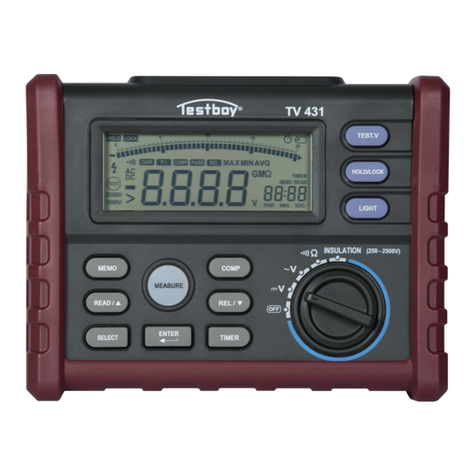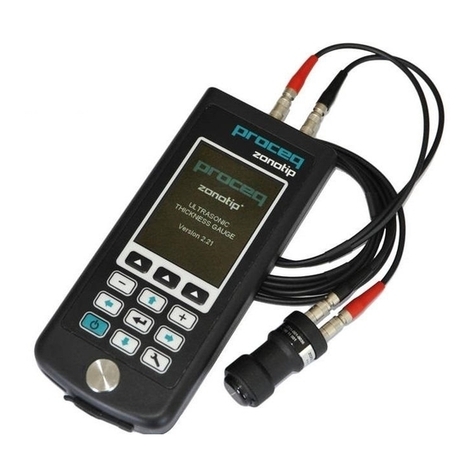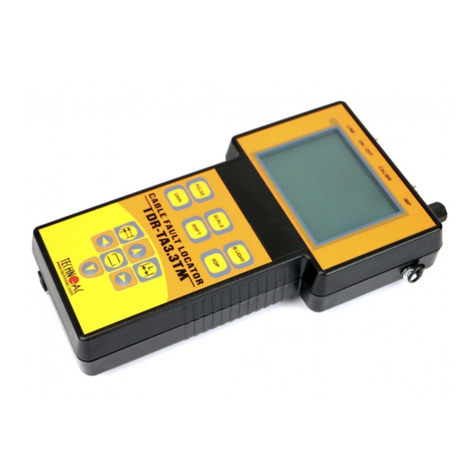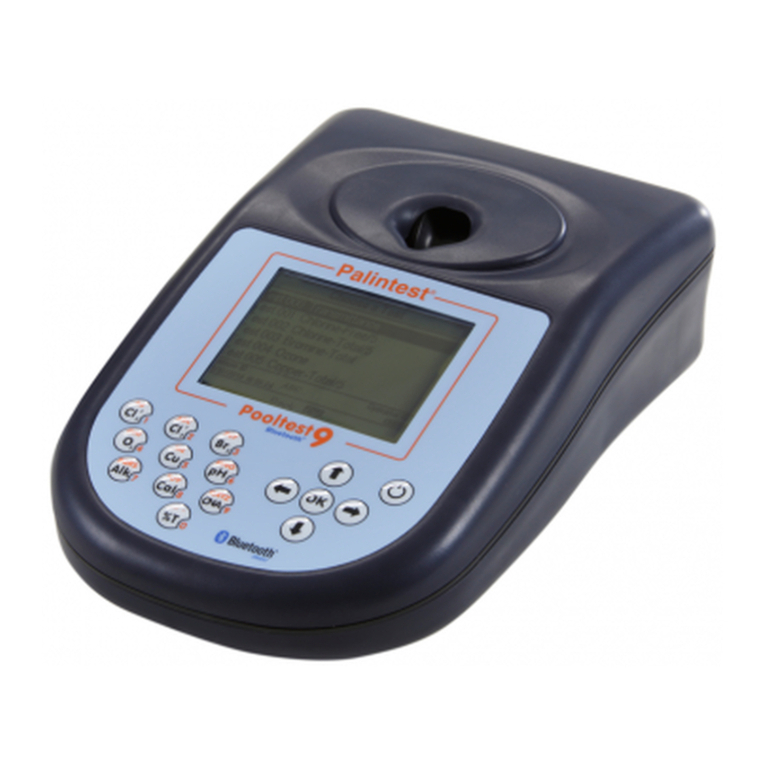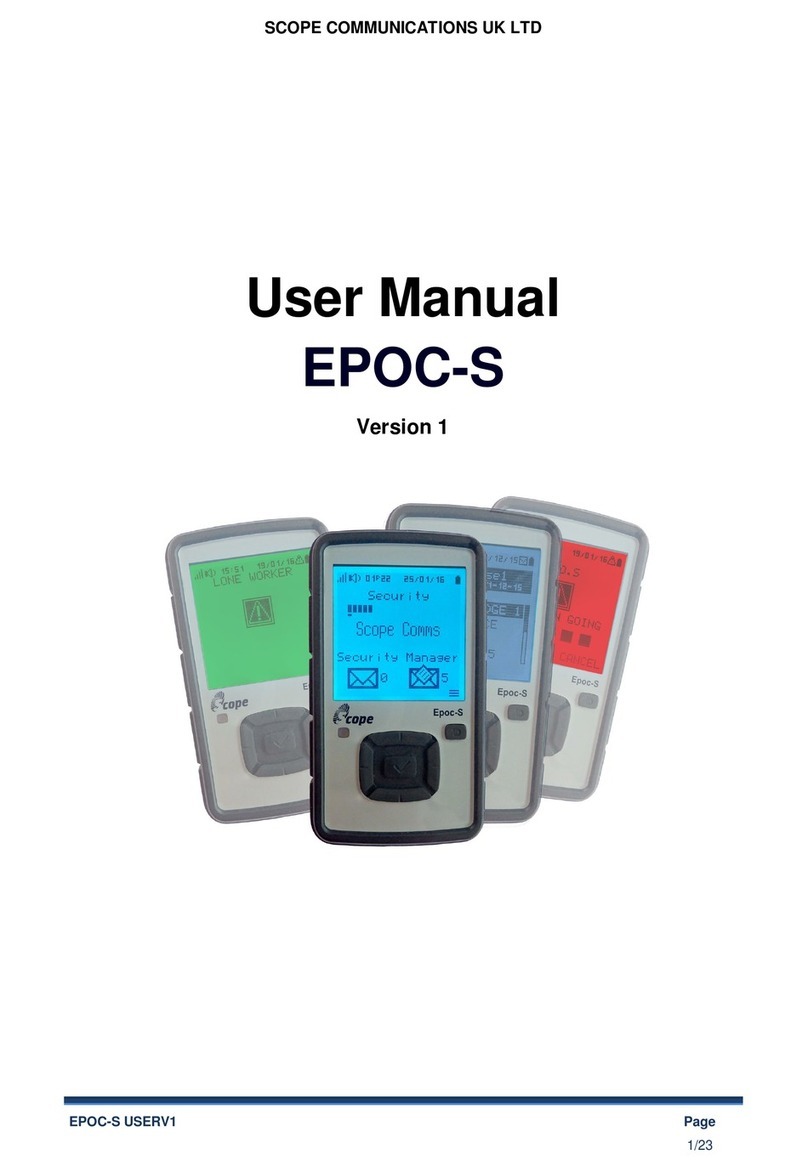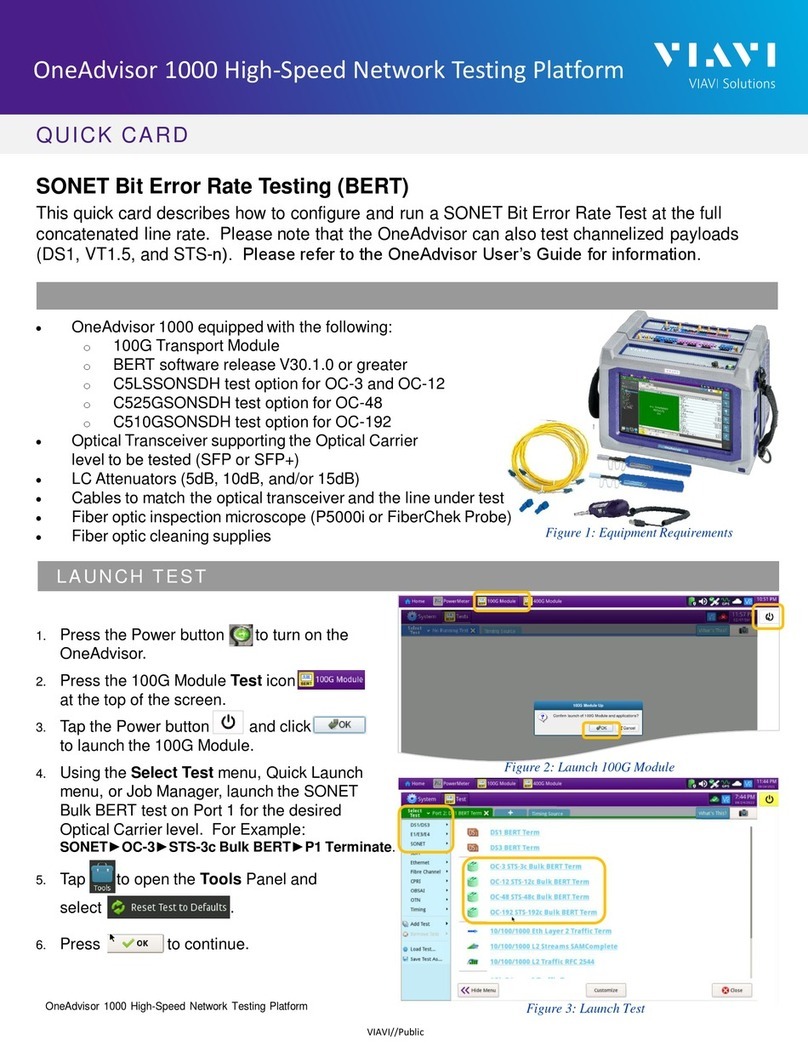Frye FONIX 8000 User manual

MAINTENANCE MANUAL
June 13, 2012
Copyright © 2012 Frye Electronics, Inc.
All Rights Reserved. Rev. June 13, 2012
FONIX® 8000


iii
Contents
Chapter 1: Overview ............................................................1
1.1 Signal Generation Overview ...............................................................1
1.1.1 Digital Basis of the Composite Signal .................................................1
1.1.2 Component Amplitude Weighting Considerations ...................................1
1.1.3 Phase of the Components............................................................2
1.1.4 Special Distortion Measurements ....................................................2
1.2 Signal Detection Overview .................................................................2
1.2.1 Fast Fourier Technique...............................................................2
Chapter 2: Specifications ........................................................5
2.1 Acoustical Outputs .........................................................................5
2.2 Telecoil Outputs ...........................................................................5
2.3 Battery Current.............................................................................5
2.4 Digital Readout of Sound Pressure Level ...................................................6
2.5 Harmonic Distortion Analyzer .............................................................6
2.6 Attack/Release.............................................................................6
2.7 Available Tests .............................................................................6
2.8 Power ......................................................................................6
2.9 Electronics Module ........................................................................7
2.10 Printer, Internal ...........................................................................7
2.11 Test Chamber .............................................................................7
2.12 Environmental Conditions ................................................................8
2.13 Monitor Headset..........................................................................8
2.14 Guarantee ................................................................................8
Chapter 3: Specification Test Procedure..........................................9
3.1 Source Frequency Accuracy................................................................9
3.2 Digital Measurement and Readout of SPL Accuracy ........................................9
3.3 Source Attenuator Accuracy................................................................9
3.4 Source Output Amplitude Accuracy.......................................................10
3.5 Telecoil Drive Current Accuracy ...........................................................10
3.6 Battery Simulator Voltage Accuracy .......................................................11
Chapter 4: Circuit Description.................................................. 13
4.1 General Description ......................................................................13
4.1.1 The following boards are used in the 8000 Main Module:...........................13
4.1.2 The following boards are used in the 8050 and 8120 Sound Chambers:.............13
4.1.3 The Probe Remote Module has:.....................................................13
4.1.4 The Single Board Computer(SBC) has: ..............................................13
4.1.5 The Parallel Interface Board has: ...................................................13

iv
4.1.6 The Printer Interface Board has: ....................................................13
4.1.7 The Daughter Board has:............................................................14
4.1.8 The Front Panel Keyboard has:......................................................14
4.1.9 The Connector Board has: ..........................................................14
4.1.10 The Chamber Board has:...........................................................14
4.1.11 The Turntable Board has: ..........................................................14
4.1.12 The Breakout Board has: ...........................................................15
4.1.13 The Probe Board has: ..............................................................15
4.2 System Block Diagrams....................................................................15
4.2.1 8000 with 7020 chamber Partial System Block Diagram .............................15
4.2.2 8000 with 8120 Chamber System Block Diagram ....................................16
4.3 Circuit Block Diagrams ....................................................................17
4.3.1 Daughter Board Block Diagram .....................................................17
4.3.2 Connector Board Block Diagram ....................................................18
4.3.3 Chamber Board Block Diagram .....................................................19
4.3.4 Probe Board Block Diagram .........................................................20
4.3.5 Turntable Board Block Diagram ....................................................20
4.3.6 Breakout Board Block Diagram .....................................................21
4.4 Circuits Detailed Description..............................................................21
4.4.1 Source Circuits Signal Flow .........................................................21
4.4.2 Measurement Microphone Circuits Signal Flow .....................................24
4.4.3 SBC to Microcontroller Digital Communication Interface ............................26
4.4.4 Power Supply and Voltage Regulators ..............................................27
4.4.5 Keyboard Interface Circuits.........................................................29
4.4.6 USB Circuits ........................................................................29
4.4.7 Turntable Circuits...................................................................30
4.4.8 LED Circuits.........................................................................30
4.4.9 Battery Simulator Circuits...........................................................31
4.4.10 Thermal Printer Circuits ...........................................................31
4.4.11 Misc Circuits .......................................................................32
Chapter 5: Calibration......................................................... 33
5.1 Microphones.............................................................................33
5.1.1 Calibrating the Coupler Microphone................................................34
5.1.2 Calibrating the Probe Microphone ..................................................34
5.1.3 Calibrating the Rectangular Reference Microphone ................................35
Chapter 6: Service and Repair ................................................. 37
6.1 Fuse Replacement ........................................................................37
6.1.1 Line Fuse Replacement .............................................................37
6.1.2 Connector Board Fuse Replacement ................................................37
6.1.3 Daughter Board Fuse Replacement .................................................37

v
6.2 Electronics Module .......................................................................38
6.2.1 Removal and Replacement of the Wrap-around ....................................38
6.2.2 Removal and Replacement of Circuit Boards .......................................38
6.2.3 Removal of Bezel ...................................................................39
6.2.4 Replacement of Keyboard ..........................................................40
6.2.5 Replacement of Printer .............................................................40
6.2.6 Replacement of Switching Power Supply ...........................................41
6.3 8000 Computer Connection (USB/Serial)..................................................41
Chapter 7: MAINTENANCE ..................................................... 43
Chapter 8: Safety Information ................................................. 45
8.1 Rear Panel Safety Markings ...............................................................45
8.2 Safety Classification for IEC 60601-1 ......................................................46
8.3 Connection of peripheral equipment to the 8000 .........................................46
8.4 Electromagnetic compatibility.............................................................46
8.5 Disposal of the 8000 and accessories .....................................................47
Chapter 9: Electromagnetic Compatibility ...................................... 49


Chapter 1: 1
Chapter 1: Overview
This FONIX 8000 Hearing Aid Test System is designed to test hearing aids. There
are two major types of hearing aid tests: coupler and real-ear.
Coupler measurements are performed in a sound chamber using a coupler or artifi-
cial ear that directs the sound to a measurement microphone. The measurement mi-
crophone thus listens to the sound coming from the hearing aid. The sound cham-
ber is constructed so that external sounds are attenuated and so that there is a place
within the box that contains a reference point where the sound is calibrated in both
amplitude and frequency. Tests can be performed with a pure tone sound or with a
composite form of sound, with many frequencies presented at once.
Tests can also be performed on the hearing aid while it is worn on an actual ear. In
this test, the sound is provided by a sound field speaker and controlled by means
of a reference microphone placed in close proximity to the test ear and hearing aid.
The sound from the hearing aid is measured by a thin hollow silicone rubber probe
tube that is placed in the ear next to and typically along side of the hearing aid ear
mold in order to pick up the sound generated by the hearing aid.
Tests can also be made of the battery current drain of the hearing aid while in cou-
pler/sound chamber mode, using a special battery pill set that is used to substitute
for the battery normally used in the hearing aid. Typically, the current is measured
while the hearing aid is being driven by a calibrated sound.
Further tests can be made of the magnetic field sensitivity of a hearing aid operated
in telephone coil mode. This is done either by use of a built in coil in the sound
chamber of the FONIX 8000 or through external telephone coil.
Intended Use:
The FONIX 8000 has two major intended uses:
•Todeterminethefunctionalityofahearingaid.Thatis,todetermineifthe
hearing aid is functioning within the hearing aid manufacturer’s specifica-
tions with an acceptable frequency response, battery current drain, distor-
tion, noise, and other characteristics as defined by the applicable standard.
•Todeterminethefrequencyresponseofthehearingaidandbeabletocom-
pare this frequency response to a target based upon the patient’s hearing
threshold levels. These measurements can be performed as real-ear or cou-
pler tests.

2 Maintenance Manual
1.1 Signal Generation Overview
1.1.1 Digital Basis of the Composite Signal
The composite signal is generated by reading 256 16-bit data words in RAM sequential-
ly and doing it over and over again. The program is able to adjust the individual am-
plitude of each signal component in the series so that it provides a correct amplitude
of drive at the test point in the chamber for each test frequency. The test microphone
is placed at the reference point in the chamber. Pushing the LEVEL button starts the
amplitude correction process. A composite analysis of the chamber is done and correc-
tion factors are calculated which alter all of the individual drive components so that
the chamber response is flat and at the desired amplitude at this reference point.
One way to think of the test waveform is to picture one sine wave of 100 Hz being built
using 256 points, or steps, through the sequential reading of a 16-bit digital RAM. If
we wanted to create a signal with two equal value components, we would arithmeti-
cally add to this wave a second sinewave, say of 400 Hz. Each cycle of the 400 Hz wave
would take exactly one fourth as many steps as the 100 Hz wave to produce (i.e., 64
steps). When these two sets of steps are added together we would get a composite wave
with two frequency components.
1.1.2 Component Amplitude Weighting Considerations
The amplitude of each frequency may also be dependent upon its placement in the
frequency spectrum. If a white noise equivalent is used, then every multiple of 100 Hz
will be used and will have an equal amplitude value. If the ANSI spectrum is to be ap-
proximated, the amplitudes of the components in the spectrum will drop at a rate of 6
dB per octave above 900 Hz when viewed on a standard Fast Fourier analyzer.
After the signal is received from the hearing aid and passed through the preamplifier,
it is run through a high frequency emphasis amplifier to restore the 6 dB/octave loss so
that we can get a compensated gain response picture.
The RMS amplitude of the drive signal increases in proportion to the square root of the
sum of the squares of all of its components. Thus, if a particular RMS value of drive
signal is needed, both the number and the individual amplitudes of all of the compo-
nents must be taken into account. A multiple frequency signal will then have smaller
component amplitudes to produce the same RMS drive to the device under test as that
of a sine wave signal drive which has only one frequency component.
1.1.3 Phase of the Components
Another interesting problem encountered is that the individual components of the
wave cannot be allowed to line up in phase, or the composite signal will consist of

Chapter 1: 3
a series of spikes with very little in between, or an impulse drive. The disadvantage
with this type of drive is that it makes very heavy demands on the dynamic range of
the hearing aid under test. Hearing aids are not known for their large dynamic ranges,
so this type of waveform must be avoided. To produce a moderate crest factor noise
equivalent, it is necessary to skew the phases of all of the components so that a given
RMS amplitude of signal has a low peak value. A computer program was used to deter-
mine the optimum set of phase values.
1.1.4 Special Distortion Measurements
Harmonic distortion tests can be run by generating a signal consisting of only one sine
component at a time, and using the Fast Fourier analysis program to determine the
spectral distribution of harmonics.
Intermodulation tests are automatically run using the composite waveform. If present,
this type of distortion is immediately apparent when viewing the gain or power re-
sponse of the hearing aid.
1.2 Signal Detection Overview
1.2.1 Fast Fourier Technique
The assumed technique for making response measurements is the Fast Fourier Trans-
form. This technique is ideally suited to a system that is used to analyze a digitally
generated waveform, since the sampling process can be locked to the signal generation
process, thus eliminating one of the main problems with the FFT, the windowing of
the measured waveform. A rectangular window is thus possible and used. That is, all
sampled components are used as measured.
1.2.1.1 Windowing
The FFT requires that the signal being sampled is exactly repetitive in order to
achieve a clean spectral display. If there is an abrupt discontinuity between the
first and last samples taken, the transform can only assume that large high frequen-
cy components are present in order to generate the discontinuity. Use of the inter-
nally generated signal helps to eliminate this problem; if a random noise is present
in the signal being measured, it will appear in the response display.
When the sound drive is switched to “OFF,” the 8000 is turned into a general pur-
pose spectrum analyzer and can be used for analysis of signals. When this is done,
mathematical windowing is used as is done with standard FFT analyzers. This
windowing is done by multiplying the first and last samples taken by a value close
to zero. The next two samples in from the ends are multiplied by a larger quantity.
In the center of the group of samples, the values are multiplied by a compensating
factor greater than unity. The function used is called a Hanning window.

4 Maintenance Manual
1.2.1.2 Aliasing
A further requirement is that the bandwidth of the measured signal be controlled
so that its frequency does not exceed a value of 1/2 the sampling rate. This fre-
quency amplitude control is done with an aliasing filter. A conservative design
stops the analysis well before the frequency limit is reached.
Aliasing shows up as a generation of random or non-random dot patterns in the
sampled data points, and occurs when the signal can take a number of excur-
sions between samples. This aliasing in an FFT will produce a number of com-
ponents in the spectrum that are really not there. It is also desirable to eliminate
the high frequency components from the signal generator portion of the system.
A smoothing filter is used there also.
1.2.1.3 Noise Reduction
The effects of ambient or hearing aid noise can be reduced by the use of time
domain signal averaging because the sampling process is exactly synchronized
with the signal generator.
Noise reduction averaging is done in steps of 2, 4, 8 and 16. The process is done
by use of an averaging buffer. The data is added to the data already in the buffer
used to create the last spectral display in a ratio of 1/2, 1/4, etc., depending on
the averaging called for. The result of the addition is then divided to get a prop-
erly scaled number. The effect of the non-synchronous noise is thus reduced
because of the averaging process.
Averaging does not slow down the display process, but does slow down the ef-
fect that an acoustical change will cause on the displayed waveform. Changes in
the phase of signals will also show up if averaging is being used. The change of
phase is accomplished by movement of the hearing aid in a sound field while the
measurement is in process. The effect of phase changes is a dropout of the signal
and an eventual recovery to the correct level when the motion has ceased.
Modern hearing aids now employ "interesting" signal processing techniques that
apparently destroy the phase relationship between input and output signals as
a means of preventing feedback. Time domain averaging does not work with
this class of device. Further, this class of aid will reduce the gain when a steady
state test signal is applied. To enable a reasonable analysis of this modern class
of hearing aid, a newer form of composite signal has been developed. It is called
"digital speech" and consists of a series of composite signal bursts to imitate
speech. The analysis of the hearing aid output has been modified as well, by do-
ing averaging in the frequency domain rather than time. Curve display smooth-
ing can also be applied to remove rough spectra that sometimes result with some
of the newer aids.

Chapter 2: 5
Chapter 2: Specifications
2.1 ACOUSTICAL OUTPUTS
Frequencies: 200-8000 Hz in 100 Hz intervals (user interface)
200-8000 Hz in 50 Hz intervals (RS232)
Frequency Accuracy: 1%
Amplitudes: 40-100 dB in 5 dB intervals coupler, 40-90 dB in 5
dB intervals real-ear (user interface)
40-100 dB in 0.01 dB intervals coupler, 40-90 dB in
0.01 dB intervals real-ear (RS232)
Accuracy Coupler: ±1 dB from 300 to 5000 Hz, all others ±3
dB (after leveling)
Real-ear: ±3 dB, 200-8000 Hz (after leveling)
Distortion (at 70 dB SPL): Puretone: < 0.5%, 400-2500 Hz
2.2 TELECOIL OUTPUTS
Field Strength: 1, 1.78, 3.16, 5.62, 10, 17.8, 31.6, 56.2, 100 mA/M
(user interface)
0-180 mA/M in 0.01 mA/M specified intervals
(RS232)
Accuracy: Accuracy: ±2 dB
2.3 BATTERY CURRENT
Readout Range: 0.00-25.00 mA
Available Current: greater than 30 milliamps
Accuracy: ± 5% of reading ± one digit
Resolution: 8 µA
Voltages supplied: 1.5 (silver), 1.3 (zinc air)
Voltage Accuracy: ±15 millivolts. (open circuit)
Resistance accuracy: (± 6% ± 0.5 ohm)

6 Maintenance Manual
2.4 DIGITAL READOUT OF SOUND PRESSURE LEVEL
Frequency Range: 200-8000 Hz
Amplitude Range: 0-150 dB SPL
Resolution: 0.1 dB
Accuracy: Coupler mic: ±1.0 dB ±1 digit, 300-5000 Hz, ±2 dB
± 1 digit all other frequencies
Probe mic: ± 2.5 dB ± 1 digit, 250-8000 Hz
Ref mic: ± 3 dB ± 1 digit, 100-8000 Hz
2.5 HARMONIC DISTORTION ANALYZER
Type: 2nd, 3rd, Total (2nd plus 3rd)
Resolution: 0.1%
2.6 ATTACK/RELEASE
Range: 1.25 to 5000 mSec.
Accuracy: Accuracy: ±10 % or ± 2 ms, whichever is larger
Signals: Puretone: 200-8000 Hz, in 100 Hz intervals (user inter-
face), 50 Hz intervals (RS232), Composite
2.7 AVAILABLE TESTS
Automated Test Sequences: ANSI S3.22-1987, ANSI S3.22-1996, ANSI S3.22-2003,
ANSI S3.22-2009, IEC 60118-7:1994, IEC 60118-7:2005,
ANSI S3.42-1992, JIS:2000
Additional Coupler Tests: Profiler, ISTS, Enhanced DSP, Input/Output, Attack &
Release, Battery Current, Coupler Multicurve, Coupler
Directional
Real-Ear: Audiogram Entry, Target Edit, Insertion Gain, Real-ear SPL,
Visible Speech
Optional: Coupler Directional (requires 8120 Polar Plot Chamber)
2.8 POWER
Source voltage: 100-240 volt AC.

Chapter 2: 7
Frequency Range: 50-60 Hz.
Power Requirement: 0.6 A.
Fuse: T 630mAL, 0.63A / 250 V~, Type T, IEC 60127-2
Sheet III (Slo-Blo Type, Glass, 5mm x 20mm). Qty 2.
2.9 ELECTRONICS MODULE
Size: 17.3"W x 10.8"D x 6.5"H (43.9 x 27.4 x 16.5 cm).
Weight: 14.3 lbs.(6.49 kg).
2.10 PRINTER, INTERNAL
Type: High speed line thermal printer
Paper width: 4.41" (112 mm)
2.11 TEST CHAMBER
8050
Test Area: 5"W x 6"D x 1.5"H (12.7 x 15.2 x 3.8cm).
Ambient Noise Isolation: 45 dB at 1 kHz (allows THD measurement to within
3% at 60 dB source level and a 60 dB ambient).
Size: 11.5”W x 13.5"D x 9.2"H (29.2 x 34.3 x 23.4cm).
Weight: 21.8 lbs. (9.9 kg).
8120
Test Area: 4"W x 4"D x 1.75"H (10.2 x 10.2 x 4.4cm) with Re-
movable Test Surface
4"W x 4"D x 1.75"H + 5.38" cavity height (10.2 x
10.2 x 4.4 + 13.7cm) with Rotating Shaft
Ambient Noise Isolation: 45 dB at 1 kHz (allows THD measurement to within
3% at 60 dB source level and a 60 dB ambient).
Size: 13.5"W x 14.5"D x 19"H (34.3 x 36.8 x 48.3cm).
Latch protrudes another 2.25" (5.7 cm) out the front
Weight: 40.4 lbs. (18.3 kg).

8 Maintenance Manual
2.12 ENVIRONMENTAL CONDITIONS
Shipping/Storage Humidity: 5 to 95 percent relative humidity (non-condensing)
Shipping/Storage Temperature: -20 to 60 degrees Celsius (-4 to 140 degrees Fahr-
enheit)
Operating Relative Humidity: 5 to 90 percent relative humidity (non-condensing)
Operating Temperature: 15 to 35 degrees Celsius
2.13 MONITOR HEADSET
Monitored channel: Probe microphone
Headphone type: Stereo 3.5mm
Usable headphone impedance: 32 ohms to 600 ohms (intended for Walkman style
headphones)
2.14 GUARANTEE
The FONIX 8000 and its accessories are guaranteed to be free from manufacturing
defects which would prevent the products from meeting these specifications for a
period of one year from date of purchase.

Chapter 3: 9
Chapter 3: Specification Test Procedure
3.1 Source Frequency Accuracy
Instrument required: Frequency counter accurate to 0.1 percent and capable of mea-
suring 1000 Hz.
Setup: Enter the Coupler screen. From the menu, set the static tone to single, and
the output transducer to Telewand. Exit the menu. Set the amplitude to 100 mA/M
and the frequency to 1000Hz. Connect the frequency counter to the sound chamber
Telewand connector.
Measurement: The frequency counter should read 1000Hz within 1% plus the toler-
ance of the counter.
3.2 Digital Measurement and Readout of SPL Accuracy
Instrument required: Precision sound level meter with 1/2 inch condenser micro-
phone. Response set to flat frequency response (C weighted).
Setup: Enter the coupler screen. From the menu, set noise reduction (tone) to “off”
and static tone to “single.” Exit the menu. Set the 8000 amplitude to 90dB. Place
the sound level meter’s microphone at the reference point in the sound chamber.
Place the 8000 coupler microphone so that its grill is facing the sound level meter’s
microphone’s grill and is 1/8" away from it. Leave the chamber lid open and make
sure the room is very quiet.
Measurement: Starting at 200Hz, measure the RMS levels at the reference point
with both systems for each puretone frequency. They should agree within 1 dB
(+/- 1 digit) from 300 to 5000 Hz and within 2 dB (+/- 1 digit) at all other frequen-
cies, plus the tolerance of the sound level meter.
3.3 Source Attenuator Accuracy
Instrument required: Precision A.C. voltmeter, such as the HP974A, that is accurate
at 1KHz, has dB relative and auto ranging features.
Setup: Enter the coupler screen. From the menu, set the static tone to “single”,
and the output transducer to “telewand.” Exit the menu. Set the 8000 to 1KHz and
100mA/M. Connect the voltmeter to the sound chamber telewand connector. Set the
meter to autoranging and dB relative modes.

10 Maintenance Manual
Measurements: Measure the voltage on the voltmeter and set the dB relative to
show 0dB at the 100mA/M setting. Reduce the output level on the 8000 to the
56.2mA/M setting and note that the meter reading goes down 5 dB (+/- .5 dB) plus
the tolerance of the voltmeter. Repeat this for the 31.6, 17.8, 10, 5.62, 3.16, 1.78 and
1mA/M settings.
3.4 Source Output Amplitude Accuracy
Instrument Required: Precision sound level meter with ½ inch condenser micro-
phone, response set to flat frequency response.
Setup: Enter the Coupler Multicurve screen. In the menu, set the noise reduction
(tone) to “off” and the static tone to “single.” In the test screen, set the 8000 ampli-
tude to 90dB. Place the coupler microphone at the reference point in the sound
chamber. Close the chamber lid. Level the 8000. Replace the coupler microphone
with sound level meter’s microphone at the reference point in the sound chamber.
Close the chamber lid.
Measurement: Starting at 200Hz, measure the RMS levels, at the reference point,
with the sound level meter, for each puretone frequency. It should read 90 dBSPL
within 1 dB from 300 to 5000 Hz and within 3 dB at other frequencies, plus the tol-
erance of the sound level meter.
3.5 Telecoil Drive Current Accuracy
Instrument required: Precision A.C. current meter that is accurate to 1 kHz.
Setup: Enter the Coupler Multicurve screen. In the local menu, set static tone to
“single” and transducer to “telewand.” Connect the current meter to the telewand
jack on the 8050 or 8120 sound chamber. In the test screen, adjust the amplitude
of the telecoil amplitude. The measured electrical output on the meter should cor-
respond to the displayed telecoil field strength within 2 dB plus the tolerance of the
current meter in the following chart:
Electrical output Field Strength
0.044 mA 1 mA/M
0.079 mA 1.78 mA/M
0.140 mA 3.16 mA/M
0.250 mA 5.62 mA/M

Chapter 3: 11
0.444 mA 10 mA/M
0.790 mA 17.8 mA/M
1.404 mA 31.6 mA/M
2.485 mA 56.2 mA/M
4.44 mA 100 mA/M
For example, if the telecoil amplitude is set to 10 mA/M, the meter should read .444
mA within tolerance.
3.6 Battery Simulator Voltage Accuracy
Instrument required: Precision D.C. voltmeter.
Setup: Connect the voltmeter to the battery pill jack in the sound chamber. Make
sure nothing else is connected to this jack.
Measurement: Press menu from the opening screen to enter the default settings
menu. Press F1 and select “coupler.” Set battery chemistry to silver. Measure the
voltage and see that it is 1.5V within 15 mV plus the tolerance of the voltmeter. Set
battery chemistry to Zinc-Air. Measure the voltage and see that it is 1.3V within 15
mV plus the tolerance of the voltmeter.


Chapter 4: 13
Chapter 4: Circuit Description
4.1 General Description
4.1.1 The following boards are used in the 8000 Main Module:
a. Single Board Computer
b. Daughter Board
c. Connector Board
d. Parallel Interface
e. Printer Interface
f. Offline Power Supply
g. Front Panel Keyboard
4.1.2 The following boards are used in the 8050 and 8120 Sound Chambers:
a. Chamber Board (both)
b. Breakout Board (both)
c. Turntable (8120 only)
4.1.3 The Probe Remote Module has:
The Probe Board.
4.1.4 The Single Board Computer(SBC) has:
The X86 microprocessor, BIOS, DRAM, Compact Flash, Display controller with
VGA Interface, Audio Codec, RS232 interface, Parallel Port, PC104 Buss, and the
Time-of-day clock.
4.1.5 The Parallel Interface Board has:
The 2x13 connector going to the SBC through a cable.
The 2x15 connector that plugs directly into (CN1) Printer Interface Board.
4.1.6 The Printer Interface Board has:
The Parallel Interface (CN1) connector.
The Power connector from the offline power supply .
The Thermal Printer Head, Stepper motor, Paper up, and Head Switch connectors.
A microcontroller and all circuits needed to drive the internal Thermal printer.
Note: A 640 x 416 dot screen image is mapped to the internal printer. Each dot is
replaced with a matrix of 2x2 pixels. The printed image is one set of 2 x 416 dots
per line, for 832 dots per line. Each line is printed twice to obtain the 2 x 2 matrix
for each dot.

14 Maintenance Manual
4.1.7 The Daughter Board has:
The power interfaces from the offline power supply, and to the SBC.
The PC104 Buss interface from the SBC to three UARTS and two RS232 interfaces.
A microcontroller that interfaces between the SBC and the circuits on the Daughter
and the Connector Boards.
The Internal and external Keyboard interfaces.
The interface to the Connector Board.
The audio connector to and from the SBC.
The measurement microphones multiplexer, two channel prescalers, ANSI equalizers,
anti-aliasing filters, and the Mic/Line multiplexer.
The speaker current measurement.
4.1.8 The Front Panel Keyboard has:
Twenty-two rubber key switches.
The connector to the Daughter Board.
The Power and Standby LEDs.
4.1.9 The Connector Board has:
The interface to the Daughterboard.
Two channel source attenuators, power amps, and relays directing to module 1 or 2.
The Frye Peripheral Interface(FPI) connectors to Module 1 and 2.
Four channel differential measurement microphone signal receivers.
The Line input and Voice Microphone inputs.
The external keyboard connector.
The RS232 to USB device port circuits and connectors.
The dual USB Host pass through connectors.
4.1.10 The Chamber Board has:
The FPI connector from the Connector Board.
An RS232 interface between the FPI and the microcontroller.
A microcontroller that interfaces between the SBC and the circuits on this board.
Relays that direct the source signals to the speaker, telecoil, or telewand.
The 7020 connector, the connector to the Breakout Board, and the Telewand Jack.
The Chamber Microphone connector, Prescale amplifiers, and differential line driver.
The Battery Simulator circuits and the Battery Pill jack.
The Power/Status and White LED drivers, and the Power/Status LED.
The Turntable control lines and connector to the Turntable Board.
4.1.11 The Turntable Board has:
The connector from the Chamber Board.
The H-Bridge driver to drive the Stepper Motor.
The connector to the Stepper Motor and Shaft Encoder.
Table of contents
Other Frye Test Equipment manuals
